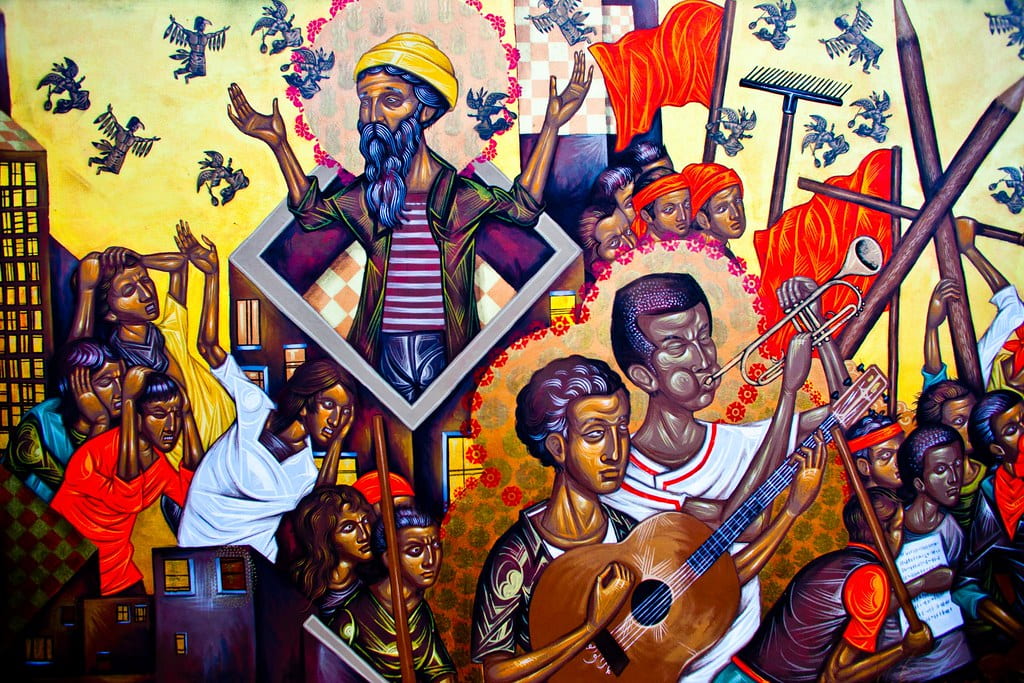Elijah Wald: how the guitar shaped – and didn’t shape – the world

Elijah Wald is a musician, writer and historian who has been playing guitar for more than 50 years. Ahead of his keynote address at the Melbourne Conservatorium of Music’s academic conferenceThe Guitar Century (c. 1880-1980): Global Trends and Local Contexts – part of the Guitar Perspectives Winter Celebration (2–4 August 2019) – he talks to Head of Guitar Dr Ken Murray.
By Dr Ken Murray
Hi Elijah. In your writing you challenge the standard narratives of 20th-century popular music and untangle the complexities involved in historical musical developments. To what extent does the guitar shape popular music during the twentieth century?
In terms of mass-market music, I suppose I’d first single out Hollywood cowboys like Gene Autry and Roy Rogers. Everyone from Jean-Bosco Mwenda in the Congo to Keith Richards in the UK was attracted to the instrument by cowboy movies, and with that came a fashion for simple, three-chord songs.
The folk boom of the 1960s was in a lot of ways just an amplification of that trend, as was rock (which also amplified it in other ways). One might say that’s the historical background to the endless discussions of folk or rock “authenticity”: cowboy romantics vs Mozart romantics.
You’ve written about many phases in the evolution of the guitar, from the 19th-century traditions of the parlor guitar, to early blues, the folk revival, Bob Dylan and The Beatles. Were 19th-century traditions of the parlor guitar and the subsequent B.M.G. movement [Banjo, Mandolin and Guitar] a strong influence on the first generation of recording guitarists in the 1920s and 30s?
I’d start with two answers: first, the middle-class popularity of guitars meant that a lot more instruments were made, and that trickled down in terms of lower prices and second-hand instruments, so led directly to a lot of rural musicians who previously could not have afforded guitars getting them.
And, of course, lots of early recording artists were directly influenced by parlor traditions – just look at all the folks who played Spanish Fandango. That said, the popularity of guitars since the 1960s has meant the instrument is wildly over-represented in reissue projects, and in terms of influence in mainstream pop, guitars were distantly behind lots of other instruments until the 1960s. (And, just to put my expertise in context: I had to google “B.M.G. movement.”)
In your keynote speech at the upcoming Melbourne Conservatorium of Music conference, The Guitar Century (c. 1880-1980): Global Trends and Local Contexts, you’ll be talking about early 20th-century guitar playing in America and the way our perceptions of this period are dominated by the extant recordings. What can we learn about the guitar-playing of this period by looking beyond the body of recorded music?
That’s what I’ll be doing my best to explore in my talk, and it’s a complicated question. But the first step is understanding that the body of recorded music represents what record companies thought they could sell, not what people were playing – and that includes people who made hundreds of recordings. To take an obvious example, Lonnie Johnson made hundreds of blues records, but seems to have always devoted most of his efforts outside the studio to performing current pop hits.
To what extent did the birth of the recording industry favour the guitar and help bring it to prominence in the twentieth century?
The birth of the industry did virtually nothing for guitars, since they didn’t record well on acoustic cylinders, but, later on, the cowboy trend made a lot of kids want a guitar, and then country singers like Eddie Arnold … and then, of course, Elvis Presley and all that followed.
On Bob Dylan’s recordings from the early 1960s his guitar playing is quite skilful, reflecting the techniques and accompaniment styles he had learnt from musicians such as Dave Van Ronk. After 1965, his guitar playing becomes much less of a feature in his recordings and performances. Do you think the instrument was less important to him after the mid-1960s?
Actually, I’d say Dylan’s guitar work was more influenced by Jack Elliott than anybody else, and that was a great model. Even the Rev. Gary Davis pieces he played mostly came from Elliott, and his very effective way of flatpicking blues.
I also hear some Everly Brothers – and, of course, a bit of Dave. As for his later playing, when he could hire some of the best guitarists in the business, he naturally concentrated on other aspects of his music. Which said, it seems to me his version of Willie McTell’s Broke Down Engine and some other blues tracks from the early 1990s are as good as anything he played in the 1960s.
Elijah Wald will be giving a keynote address as part of the Melbourne Conservatorium of Music’s Guitar Perspectives Winter Celebration (2–4 August, 2019).